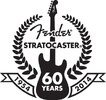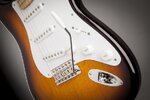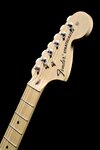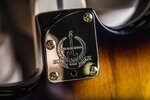hack_meck
Lounge .&. Backstage
FENDER® STRATOCASTER®, WORLD'S GREATEST ELECTRIC GUITAR, TURNS 60




SCOTTSDALE, Ariz. (Jan. 6, 2014) — The Fender Stratocaster guitar turns 60 in 2014, and it wears it well. You see the instrument everywhere, and hardly a day goes by when you don't hear its signature sound. It was so essentially and remarkably right from the very start in 1954 that it has shaped popular music for 60 years virtually unchanged. A great deal of the music you love—the very soundtrack of your life—was and is made with a Stratocaster.It is the guitar behind the sound of "That'll Be the Day"; (the Crickets, 1957), "Purple Haze"; (the Jimi Hendrix Experience, 1967), "Smoke on the Water"; (Deep Purple, 1972), "Pride and Joy"; (Stevie Ray Vaughan and Double Trouble, 1983), "Even Flow"; (Pearl Jam, 1992), "Dani California"; (Red Hot Chili Peppers, 2006), "Get Lucky"; (Daft Punk, 2013) and countless other hits. After 60 years, the Stratocaster remains a fantastic tool at heart. It delivers unmistakable sound and timeless design that havemade it the first choice among players everywhere."I've moved around with many guitars and tried many different things, and I've always come back to the Stratocaster,"; said Eric Clapton, whose long devotion to the Stratocaster began in earnest in 1970 when he used his 1956 model, "Brownie,"; to record his eponymous debut solo album in January of that year, and Derek and the Dominos magnum opus Layla and Other Assorted Love Songs that fall.Jeff Beck attributed the "ultimate sounds known in the 20th century"; to the Stratocaster, and George Harrison once asserted, "You can't beat the Strat … I don't care what you say."; After the introduction of the Telecaster® and Precision Bass® guitars in 1951, company founder Leo Fender turned his attention to a bold new guitar design. The instrument, designed by Leo Fender himself and named the "Stratocaster"; by Fender sales chief Don Randall, debuted in 1954. An extraordinary new guitar with several ingenious design innovations, the Stratocaster proceeded to revolutionize popular music as an indispensable tool of phenomenal creativity, and even transcend that role to become a cultural symbol.The Stratocaster is an archetypal electric guitar. When many people think of an electric guitar, it is the one that immediately comes to mind. Those who invented it and built it, those who played it then, those who play it now, and those great many more who have lived their daily lives with a wonderful soundtrack provided by it have elevated the Stratocaster to much more than the sleek sum of its smartly designed parts.Perfected by 1957 into the form that has remainedlargely unchanged ever since, the Stratocaster sang with a sparkling tone that captivated players. Further, its mid-'50s arrival also coincided nicely with a powerful new musical and cultural phenomenon called rock 'n' roll.It didn't take long for the Stratocaster to catch on, especially after millions got a good look at one when Buddy Holly played his on The Ed Sullivan Show in late 1957. And from the 1960s onward, players have put the Stratocaster to wildly imaginative uses never envisioned by the guitar's creators and earliest champions. It really has revolutionized popular music everywhere.The Stratocaster rode the huge vocal and instrumental surf music wave of the early 1960s, exemplified by debut Beach Boys album Surfin' Safari and the exotic instrumental fury of Dick Dale's "Misirlou,"; both from 1962. Jimi Hendrix caused a sensation with his literally incendiary performance at the Monterey International PopMusic Festival in Monterey, Calif., in 1967, concluding his band's startling set by smashing his '65 Stratocaster and setting it aflame onstage. The performance made Hendrix—already popular in the U.K.—a star in the United States.
The 1970s was an especially fertile period for the Stratocaster. As noted, Clapton's use of the instrument on his 1970 solo debut and Layla and Other Assorted Love Songs drew great acclaim. When the members of Deep Purple watched from their hotel on the shores of Switzerland's Lake Geneva as the nearby Montreux Casino was destroyed by fire on Dec. 4, 1971, they were inspired by the "fire in the sky"; and the smoke drifting over the lake to compose 1972 proto-metal classic "Smoke on the Water,"; for which guitarist Ritchie Blackmore created the most imitated Stratocaster riff ever. And among the many great Stratocaster solos crafted by David Gilmour throughout Pink Floyd's lengthy career, those for "Comfortably Numb"; and "Another Brick in the Wall Part 2"; from bleakly mesmerizing 1979 masterpiece The Wall are routinely ranked among his greatest.
An especially colorful year for the Stratocaster came in 1983 with two chart-topping comebacks: David Bowie's Let's Dance, on which millions of listeners worldwide get their first tastefully blistering earful of a young Texas blues virtuoso named Stevie Ray Vaughan, and Yes's 90125, on which South African guitarist Trevor Rabin uses his '62 Strat, most notably for a strikingly angular solo on number-one hit "Owner of a Lonely Heart.";
The Stratocaster entered the 1990s stronger than ever. Kurt Cobain recorded a great deal of industry-changing Nirvana juggernaut Nevermind, released in September 1991, using a Stratocaster. Thus, the same guitar behind the foot-tapping sound of 1957's "Peggy Sue"; was also behind the intensely aggressive sound of the biggest rock phenomena of the modern era, grunge and alt-indie. The Stratocaster also fueled many '90s tracks by major acts such as Smashing Pumpkins and the Red Hot Chili Peppers.
As it entered the 2000s, the Stratocaster remained on the forefront of modern music propelling songs like The Strokes' 2001 youthful hit "Last Nite,"; Audioslave's 2003 power anthem "Show Me How To Live,"; John Mayer's 2006 lilting "Gravity,"; Cee Lo Green's 2010 "Forget You,"; and the instantly recognizable song of 2013, Daft Punk's "Get Lucky,"; which features funk master Nile Rodgers' 1959 Fender Stratocaster known as The Hitmaker for producing the sounds behind some of the biggest-selling albums of all time.
The Stratocaster is still the future of electric guitar as of its 60th anniversary in 2014, just as it was the future of electric guitar when it debuted in 1954. Fender continues to innovate with the Stratocaster, developing brand-new models equipped with the very latest electronic and digital technology. These new Stratocaster models will deliver electrifying new playing experiences to guitarists everywhere and usher the world's greatest electric guitar into a bright and bold new era.
After six incredibly colorful and wonderfully musical decades, the Stratocaster is beautiful, as always. It is timeless, as always. It sounds phenomenal, as always. The Stratocaster is poised for a brilliantfuture, as always.
For more information, go to fender.com/strat-60th.
- Eigenschaft
Zuletzt bearbeitet von einem Moderator:
